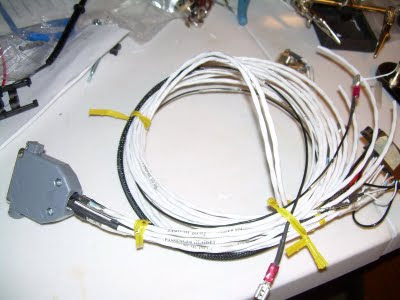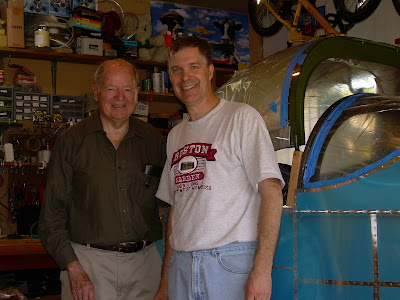Today, I was "that guy," but I like to think I wasn't as clueless as the term suggests.
You see, we had a day and a half of rain after a snowfall, and then a freeze, so the taxiways at Flying Cloud were pretty much straight ice. There's been a lot of construction at KFCM in the last year, too, so things aren't necessarily where they were before.
My currency with the FBO expires next week, so I went out today to shoot some touch and go's. With so much of my money going into building the RV-7A, I don't fly very often -- certainly not enough to be proficient. But I'm aware that one of the problems of homebuilding is that pilots stop flying during the construction period, so I've been faithful to keep flying during the time, if only a little bit. When I do fly, I treat it as a training flight. All of my flights are usually local, and all of my activity is usually practicing air work. I also spend a lot of time reading and educating myself about flying, especially the FAA material on runway incursions.
But sometimes the strategies and procedures for avoiding runway incursions, don't help you much.
The day started bright and beautiful but by the time we pulled the Warrior out of the hangar, the snow showers had moved in. The controller directed me to 28R, but I'd seen its condition and asked for 28L instead. "Taxi to runway 28 Left by taxiways Alpha and Charlie," he said.
My airport map didn't list Charlie, and Charlie didn't use to exist, so I asked for progressives. By the time I reached it, I could spot the bright yellow sign so I canceled the progressive taxi instructions.
Usually, I run-up the engine and do my final pre-takeoff check next to 28R. But the ground controller gave me clearance to taxi to 28L, which gives me clearance to cross
I decided I'd head over to the other side of 28L and do my run-up there. So I crossed the end of 28R on taxiway Charlie. It was glare ice and I was going very slowly. There's a hold-short line just before
"Tower, I've skidded past the hold-short line," I advised. After a moment, the controller cleared me across 28L and helped me fumble around looking for the runup area.
I spent the next hour shooting touch-and-go's. It was difficult seeing much because frost covered the sides of my windows and the snow showers were making life difficult keeping an eye on a Sundowner in the pattern. But all in all, it was a good hour. None of the landings were particularly good, but none were nauseating either.
As I was downwind for 28L, I advised the controller this would be a full-stop landing, he cleared me to land and when I did, I taxied all the way to the end of the runway and turned off. Ground control cleared me to taxi, and then said "N7337V, possible pilot diversion, call the tower, prepare to copy the number."
I got the phone number and thought, "Oh, sh*t, I bet he cleared me to land on 28R that last time, since that's closer to the FBO."
I shut down, paid for the plane, and then called the tower. "Let me guess," I began, "you put me on 28R on that last down?"
"No," the tower supervisor said, "it was skidding past the hold short line."
He couldn't have been nicer, but said they had to report it as a runway incursion. So he took all of my information after I told him what had happened. He said he doesn't know what happens now, but eventually I'll hear from the FAA. I filled out the NASA reporting form. It's not a get-out-of-jail free card but in assessing the penalty, they take under advisement the "attitude" of the pilot and filling out the NASA form (which provides aviation with safety violation information so they can determine what's a problem and what should change, if anything).
Looking back, I realize there's no way the tower could've known I'd passed the hold short line. I was only over it by a couple of feet, and the line wasn't visible from the tower. But I told them what I'd done and I feel OK about that.
What could I have done differently? First, there was a stack of new airport diagrams at the FBO, but they were covered up by an airport newsletter. The airport diagram wasn't the problem here, but knowing construction had been completed, I could've searched out an updated diagram.
I also could have asked the ground controller to let me do the run-up next to 28R, but the condition of the taxiway and the run-up area was -- in my opinion at the time -- likely to be much better on the other side, and even if I'd done that, I still would've approached the hold-short line.
I could have gone slower, but I was barely traveling at the rate of a casual walk as it is. Plus I'd also tested the conditions three times -- once when I turned onto the taxiway, once at the hold-short line for runway 18, and once just before I turned onto taxiway Charlie. Anytime I cross a runway, I try to get across it quickly, so perhaps I picked up speed a little when crossing 28R; I don't know.
I could've stayed on the ground, but I'd never taxied on ice before, not flown in the conditions that were present that day and I wanted to stretch my experience, especially in the controlled environment -- more or less -- of the traffic pattern. There was a time I didn't do well in crosswinds, so I started flying more in crosswinds. I'm very good at crosswind landings now. That's simply how it works.
But flying is a matter of confidence and when you go out for a workout, ending it with a call to the tower negates whatever 'good' might've come out of the day. On the other hand, it also makes you want to go back out and prove you're focused, situationally aware, and educated. That's a good thing.
I'll let you know what I hear.




































